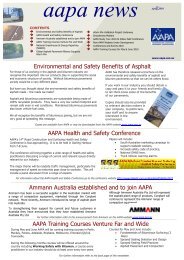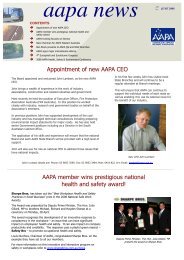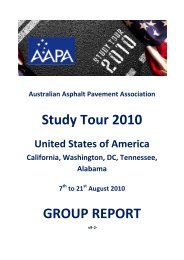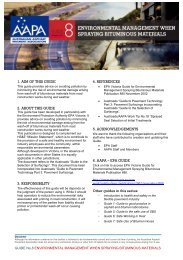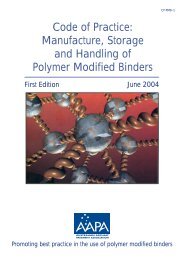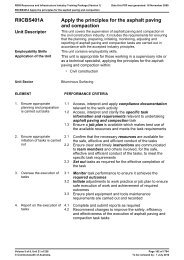Asphalt Review - Volume 32 Number 3 (Jun / Juy 12) - Australian ...
Asphalt Review - Volume 32 Number 3 (Jun / Juy 12) - Australian ...
Asphalt Review - Volume 32 Number 3 (Jun / Juy 12) - Australian ...
You also want an ePaper? Increase the reach of your titles
YUMPU automatically turns print PDFs into web optimized ePapers that Google loves.
ASPHALT REVIEWCEO’S REPORTJohn Lambert,CEO, AAPAThose of us living in the south of Australia willbe noticing that the weather has become coldand sometimes wet.As winter approaches, it reminds me ofthe importance of good quality roads, roadsthat we feel safe to drive on. This requiresgood quality and maintained asphalt or sealedroads. It also requires well marked roads as isdone by our colleagues in the Road MarkingIndustry Association.Wet weather is also a time when conditionsdo not allow for roads to be properly surfaced.This may be winter periods in the south andthe monsoonal periods in the north. Althoughthese periods may be down time for surfacing,they give companies the opportunity toprovide training for work crews.In the Chairman’s report in this edition of<strong>Asphalt</strong> <strong>Review</strong>, Sergio Cinerari highlights theimportance of worksite safety. Wet periodsare a great opportunity to provide training forcrews in health and safety, as well as in a rangeof other directly relevant areas of our work.Health and safety training ensures thatnew workers understand the risks. It alsoreminds experienced workers of the risksand reduces the likelihood of these workersbecoming complacent.The AAPA Working Safely with Bitumentraining course is one way workers canbetter understand the risks associated withhandling hot bitumen. This course should bedone by every new worker in their first year.Experienced workers should also complete thecourse every four or five years to remind themof the risks. AAPA is also developing a short,on-line induction course that new workerswill be able to do as soon as they commencework. It will also be available for experiencedworkers to do annually as a refresher course.Information on the Working Safely withBitumen course is available on the AAPA websitealong with a calendar of scheduled courses.Additional courses can also be provided upondemand. Please contact the AAPA office if youwish to inquire about a course.As well as training in the handling ofbitumen, the wet periods across Australiaprovide the opportunity for workers toreview their safety procedures such asthose associated with working in a confinedworksite with moving vehicles and workingwith passing traffic on sites where the roadhas not been able to be closed. Regular toolbox meetings throughout the year shouldalso stress these issues.Wet periods also provide a time to provide arange of training in other areas and AAPA offersa range of relevant courses including courses onasphalt placement and compaction and sprayedsurfacing. Information on these courses canalso be found on the AAPA website.At the time this edition of <strong>Asphalt</strong> <strong>Review</strong>was being prepared, the Eurasphalt andEurobitume Congress was being held atIstanbul in Turkey.This congress attracted delegates fromEurope and the rest of the world. It is heldevery four years and has a wide range ofrelevant papers, displays and exhibitions.The theme for this year’s Congress was<strong>Asphalt</strong>, the sustainable road to success.A delegation of AAPA members fromAustralia attended the congress and some ofthe most relevant papers will be printed in thenext edition of <strong>Asphalt</strong> <strong>Review</strong>.The <strong>Australian</strong> delegation was alsoundertaking a study tour of Europe, visitingresearch organisations, government roadauthorities and industries in the UK, France,Netherlands, Turkey and Germany.Delegates on the tour identified five keyareas of information.• Long Life Pavements;• High Performance <strong>Asphalt</strong> and Binders;• Sustainability;• Health and Safety; and• Procurement Systems.They also identified over 250 questions thatthey forwarded to the organisations they werevisiting to ensure that the people being metwere able to prepare.The AAPA WorkingSafely with Bitumentraining course is oneway workers canbetter understand therisks associated withhandling hot bitumen.This course shouldbe done by everynew worker intheir first year.As with previous study tours, AAPA willbe holding feedback sessions providinginformation on the outcomes of the tours.These will be held in each of the larger capitalcities. Information on these feedback sessionswill be provided on the AAPA website and inmembers’ newsletters.Before finishing this report I shouldcomment on the recent changes being madeto state government specifications relatingto warm mix (WMA) and reclaimed asphaltpavement (RAP). The AAPA/AustroadsWarm Mix Validation Project has now beencompleted and, even though the final reporthas not been finalised, it is obvious that thehypothesis that warm mix performs the sameas hot mix has been proven to be correct.It is clear that warm mix should bepermitted and is it pleasing to note that theRoads and Maritime Services in NSW hasalready included WMA in its specification.Vicroads is also in the process of amendingits specifications. The use of RAP, includingin WMA is also increasing and it is clear thatin hot mix amounts of 15% should be readilypermitted and even higher percentages inwarm mix.We can often be slow in Australia to pickup technologies that have been provenoverseas. While it is appropriate to movecautiously, I believe that in the case of warmmix and RAP, it has been proven sufficientlyto allow the use of both without unnecessaryrestrictions. The advantages of these twotechnologies, particularly the cost andenvironmental advantages of RAP, mean thatwe should be using these technologies acrossthe whole of Australia. ■30 ROADS JUNE/JULY 20<strong>12</strong>
ROAD WIDENERSWIDEN YOUR PROFITThe Weiler W530 Road WidenerROAD WIDENERSROAD WIDENOne Machine to Do it All.Jobs that previously took two, maybethree machines can be completed withthe single-operator Weiler W530.• Work faster—speeds up to222 m/min (730 ft/min)• Precise material control—above, below or at grade• Levels materials as they’replacedMaterials• <strong>Asphalt</strong>• Aggregate• Concrete• Soil• SandApplications• Shoulders• Sub-base• Trench FillsTo learn more about the W530 andother Weiler road building equipment,log onto www.weilerproducts.com.© 20<strong>12</strong> Weiler, All Rights Reserved. Weiler, its respective logo and the corporate and product identity used herein are trademarks of Weiler and may not be used without permission.SIMPLE OPERATION. PROVEN PERFORMANCE. POWERFUL RESULTS.
ASPHALT REVIEWCHAIRMAN’S REPORTSergio Cinerari,Chairman, AAPAThe construction industry can be a dangerousenvironment to work in – when risks are notunderstood and, sometimes not controlled,the situation only worsens.I am sure that like me, you have allseen pictures of workers on constructionsites in the early 1900s without any safetyequipment; the notion of steel-toe-cap bootsand high visibility clothing, whilst the mostbasic of requirements today, was not even aconsideration back then.With the passage of time, however, ourindustry has been on a journey which hasseen it continually improve worker safety onour sites. I recall joining Emoleum in the early1980s just as the road surfacing industry wasintroducing and placing greater emphasis onthings like bright coloured clothing for safetyand long sleeves/pants. Back then I rememberthe “old hands” saying that all “these thingswere over the top and that it will never last”.How wrong they were; today theseinitiatives, amongst many others that makeour sites safer, are ingrained in the way wework. In fact we now take these initiativesfor granted, but as with all change at thetime of its introduction, paradigms andunderstandings are challenged and because ofthis, change seems daunting at times.I am saddened to note, however, thatdespite the many improvements in safetyover the years, there have still been fivedeaths in Australia and New Zealand over thelast two years.These incidents have all involved themovement of plant on our sites and theinteraction of our plant and people withthe travelling public. The issues relating tothe worker/plant/travelling public interfacecontinue to be of the gravest concern to ourindustry and all its stakeholders.In the past, and to this day, our industryhas shown itself to be innovative andresilient and, just as in the early 80s whenfaced with the requirement to make ourworksites safer, I am firmly of the beliefthat we can apply those same qualities tothe challenge of stamping out work placeaccidents caused by the worker/plant/travelling public interface.The challenge for all stakeholders in theroad surfacing industry is and, always hasbeen, to continually improve safety on andaround our sites. We should all have zerotolerance for worksite safety incidents andcertainly we should not have any fatalities.It is not good enough to engage in a fingerpointing exercise or to simply believe thatthe practices that have served us well in thepast will overcome the issues that face thisindustry now. It is time to look at how weexecute and specify the work to be done,both contractors and clients, and to findways of eliminating the risk associated withthe plant/worker/ travelling public interface.We must all work towards zero tolerance toworkplace deaths or injury.With this in mind, the AAPA Board hasdirected that the next AAPA Health andSafety Conference in October provide aforum for participants to work together toachieve the goal of zero tolerance for workplace deaths and injury.I will be inviting senior managers fromour major producer member companies toan afternoon session on the Sunday beforethe conference to start the conversationand exchange ideas on this most seriousissue. The conference will then hold a seriesof workshops to identify practical meansto continue to improve health and safetyacross our industry.It is my aim and that of the Board tomaintain a major focus on health and safetyas we all recognise that five deaths in twoyears is five too many. This will include somesignificant projects being undertaken byAAPA nationally and by its Branches. Butremember, it is not up to AAPA to improvehealth and safety; it is up to you and me.I look forward to your contributions at theAAPA Health and Safety conference. ■The challenge forall stakeholders inthe road surfacingindustry is and,always has been, tocontinually improvesafety on andaround our sites. Weshould all have zerotolerance for worksitesafety incidents andcertainly weshould not haveany fatalities.<strong>32</strong> ROADS JUNE/JULY 20<strong>12</strong>
1000M SERIES.THE INNOVATIONCONTINUES.M SERIES. 1000 AT WORK.
ALL WHEEL DRIVE.ALL WHEEL PERFORThe Cat ® 140M, including theindustry-leading All WheelDrive system, delivers greatermachine versatility, utilisationand performance.Around Australia, there are now onethousand Cat ® M Series Motor Gradersbeing put to work. We’re proud of thismilestone but remain focused on continuingto deliver technology innovations that makeoperators more comfortable, worksites moreproductive and businesses more profitable.M SERIES. 1000 AT WORK.All Wheel Drive (AWD) is a must havefeature for those who work in traction-limitedconditions such as mud, sand, gravel, or snow.An AWD system can also be beneficial onside slope applications, where the additionaltractive effort can help keep the grader fromsliding off the intended line of travel.AWD can boost performance with addedversatility, stability, and an overall increase inpower and torque. The Cat AWD variable frontdrive motors powered by separate dedicatedleft and right hydraulic pumps provide theproper match between torque and speed, sowhen operating in the lower working gears,you will have over 50% more torque than theprevious Cat H Series. If working in a highspeed, loaded condition, you will still havethe necessary pull to power through heavyunderfoot and/or hilly terrain, due to the infinitevariable ratio between torque and speedthroughout the forward and reverse gear range.The Cat AWD infinitely variable pumpsand motors maximise torque in each gearand deliver maximum power to the ground,increasing productivity.
MANCE.Three Mode Operation & Front Wheel Speed Setting –There are three modes of operation for the AWD system:• AWD Off (rear tandem drive only)• All Wheel Drive• Front Wheel Drive-OnlyIn All Wheel Drive mode, front wheel speed can be adjustedup to <strong>12</strong>0% of rear tandem wheel speed.Front Wheel Drive-Only Mode – Standard with AWD, thismode disengages the transmission and provides hydraulicpower to the front wheels only. The ground speed is variablebetween 0-8 km/h (0-5 mph), perfect for precise finish work.Max Net Power to Ground – When the AWD system isengaged, fl ywheel horsepower is automatically increasedby as much as 15% over the base tandem drive power level.This increase in gross power offsets the parasitic lossesassociated with the AWD system and maximises the netpower to the ground for increased performanceand productivity.Cat Steering Compensation – The Cat SteeringCompensation System is standard with AWD. This featureenables a “powered turn” by adjusting the outside front tyrespeed up to 50% faster than the inside tyre. In addition,inside front tyre speed is automatically adjusted faster thanthe inside tandem tyre. The result is improved control, lessdamage to surfaces and a dramatic reduction of turningradius in poor underfoot conditions.The Cat AWD system will ensure you can get the job done inany application and condition.Cat ® C9 ACERT VHP Plus – AWD ModelBase Power(AWD on, 1st gear) – Net 166kW 223 hpVHP Plus Range – Net 166-200kW 223-268 hpGross Vehicle Weight – Max– Total with AWD 23,538kgWith steeringcompensationWithout steeringcompensation
1000M SERIESWORKING FORAUSTRALIANSGilbert Mining Group was the first company inthe Northern Territory to purchase M SeriesMotor Graders. Owner and operator PaulGilbert talks about how he and his team havebeen putting the machines to work ever since.Gilbert Mining Group has been in business for13 years and employs 40 operators. They dorural road construction and airstrips and havejust moved in to mining, where they also buildroads and airstrips, as well as work a variety ofother machines, which are all Cat machines bythe way – all 24 of them.Included in the fleet are four M Series MotorGraders. Owner and operator Paul Gilbert says,“We were the first company to buy an M Seriesin the Territory and at that time I also had a Gand an H Series Grader. I sold the G and was goingto keep the H but after driving the M Seriesfor two days, I sold the H and bought another MSeries straight away. It was that good to drive.And easy - you get used to it quite easily. You’llnever go back to an H Series Grader after drivingthe M Series.”Of course Paul also had to convince his othergrader operators that the M Series was the wayto go.“When a lot of my operators, especially the oldschool operators, saw the grader, they weresheepish to say the least. They walked around it,looked at it and weren’t sure what to think. Butonce they got it, and spent a day on it they lovedit and they’ll never go back to the older graders -that’s for sure.“It’s so much easier to drive - in my opinion it’sbetter on your body and you don’t get a soreback. And the ease of operating it is fantastic- you just keep your hands there. You’re sittingthere, looking up the road and operating thegrader.“The operators all comment on the viewswith the grader because the cab’s not squareanymore - it’s on an angle because there’s nosteering wheel in front of you. They can see thewhole blade and know exactly what the machineis doing. They say the machine is so muchmore responsive in every way - they love it.“We do a lot of mixing up here. The graderspends about 80% of its time mixing the gravelso you’re up and back and you’re turning around.The joystick controls are great because theoperators can spin around so quickly and thenthey’re back in the mix heading the other way inno time at all. And even when they’re laying out,they can just see everything - it’s so much easierfor them to do.“The other reason I like the M Series Grader isthat overall productivity is up because the operatorswant to get in the machines. Up here in theTerritory we do <strong>12</strong>-hour days on the roads and inthe mine. So they’re long days but the operatorsare quite happy to sit in them all day.“When we purchased the first M Series, the Catdealer organised for a trainer to fly into AliceSprings and he spent a day familiarising us withthe machine and how it works. Their servicewas magnificent. They went right through thewhole machine with us and then we’ve trainedup a couple of our people. And now if anyonenew comes along, we’ll teach them.“It only takes a couple of hours for them to gettheir head around it and by the end of the daythey’re fine. Within a week you’re as good as youwere on previous graders but with better results.“And when it comes to backup and support,we’re covered. We’re in the middle of nowhereup here and when things break down it costsyou time and money - so we’ve stuck with Cat.The Cat dealer rep always comes down and hesupports us 100%. They always keep in contactwith you.“We’re very happy with the graders, the productivityand how they perform. When it comes tothe joystick controls, at first I couldn’t see howit could work. But once I got my head aroundthe technology and what they’d done, I realisedthey’d done it the right way.”To find out more about the range of Cat M Series Motor Graderscontact your local Cat dealer or visit australia.cat.com/mseriesNSW/ACT - WesTrac: 1300 881 064WA - WesTrac: 1300 881 064VIC - William Adams: (03) 9566 0666TAS - William Adams: (03) 6<strong>32</strong>6 6366QLD/NT - Hastings Deering: 131 228SA - Cavpower: (08) 8343 1600Note: Caterpillar makes no warranties, guarantees or representations as to the accuracy or timeliness of any information, beliefs or opinions (which do not necessarily reflect thebeliefs or opinions of Caterpillar) set out above and Caterpillar assumes no liability or responsibility for any errors or omissions in same or actions in consequence upon same.© 20<strong>12</strong> Caterpillar. CAT, CATERPILLAR, their respective logos, “Caterpillar Yellow,” the “Power Edge” trade dress as wellas corporate and product identity used herein, are trademarks of Caterpillar and may not be used without permission.
<strong>Asphalt</strong> reviewTest Track ShowsOutstanding Results forWarm Mix with 50% RAPArticle Courtesy of NCAT. By David H. Timm,Adriana Vargas-Nordcbeck, and J. Richard Willis*Researchers at the National Center for <strong>Asphalt</strong>Technology’s Test Track have observedexcellent results from an experiment pittingconventional pavement mixes against mixescombining recycling and both hot-mix andwarm-mix asphalt.They constructed a control section ofconventional hot mix, an experimental sectionusing hot mix with 50% RAP (reclaimed asphaltpavement), and another section using warm mixfrom a foaming device with 50% RAP. The high-RAP sections had the same total thickness as thecontrol section. In the latest cycle, concludedin September 2011, the high-RAP warm-mixsection performed equal to the control.The attractions of high-RAP and warmmix are compelling for both economicand environmental reasons. Faced withincreasing material prices and trafficdemands, pavement and materials engineersare constantly searching for innovativeapproaches to creating high-performing,long-lasting, and, most critically, economicalpavement structures.Use of RAP has been extensive for thepast 30 years (McNichol, 2005). However,Figure 1. Pavement Materials and Cross Sectionsthe amount of RAP allowed in pavementmixtures has been limited by some statesdue to concerns about the stiffness ofthe aged binder in the RAP and lackof documentation about long-termperformance of high-RAP mixes.Currently, average RAP contents are about18%, with 15 states allowing greater than30% while a few states permit little or no RAPusage (Hansen et al., 2011).Agencies and industry recognize thatincreasing average RAP contents up to 25%could cut life-cycle greenhouse gas emissionsby 10% (NAPA, 2009). In addition, warm-mixasphalt (WMA) has taken the industry by storm;the tonnage produced in the U.S. more thantripled from 2009 to 2010 (Newcomb, 2011).Current estimates are a 20% energyreduction when utilizing WMA duringproduction (NAPA, 2009).Though warm mix and recyclingtechnologies were developed independently,agencies have begun to consider combiningthem to achieve even greater environmental,performance, and cost benefits. NAPA (2009)estimates that 25% RAP combined with WMAcould reduce greenhouse gas emissions by 3million tons per year.Achieving even higher RAP percentagescould have an even greater impact fromsustainability and cost perspectives. Inaddition, the use of WMA technologies canhelp improve workability, which is often anissue for high-RAP mixtures.To explore the use of high RAP and warmmix, these materials became the mainfocus of a group experiment that began in2009 at the Test Track. The experiment wassponsored by the Alabama, Florida, NorthCarolina, South Carolina, and TennesseeDepartments of Transportation and theFederal Highway Administration. The studyconsisted of two sections with 50% RAPthat have endured 10 million standardaxle loadings, with performance equal to acontrol section placed at the same time.Materials andCross SectionsWithin the experiment, there were three testsections, with each section having a surface,intermediate, and base mixture. The firstsection was the control; it did not includeany RAP and the mixtures were producedas conventional hot mixes. The second testsection contained 50% RAP in each layer andthe mixes were produced as hot-mix asphalt(RAP-HMA). The third group used the same50% RAP mixes, but the mixes were producedas WMA using a foaming system (RAP-WMA).The virgin aggregate used in all threesections was a combination of granite andlimestone. Each mixture was designed to 80gyrations following the Superpave procedure.Within the 50% RAP materials, fractionatedRAP was used for the surface (15% fine and35% coarse RAP) and intermediate/basemixtures (20% fine and 30% coarse RAP).Figure 1 illustrates the cross sections andas-built thicknesses with nominal maximumaggregate size (NMAS), virgin PG bindergrade, and mixing temperature noted foreach lift placed. Slight differences in totalROADS JUNE/JULY 20<strong>12</strong> 37
ASPHALT REVIEWFigure 2. Pavement Response Under Trafficthickness were noted and adjusted for duringdata analysis. Each section was placed on thesame 6-inch aggregate base and subgradefoundation. Additionally, gauges wereinstalled in each section during constructionto measure pavement response under trafficthroughout the two-year experiment.Testing and EvaluationConstruction was completed and thesections were opened to traffic on August28, 2009. A fleet of five triple-trailervehicles circled the Test Track 16 hours aday, five days a week for a two-year periodto accumulate approximately 10 millionstandard axle loads. During this time,extensive monitoring using the embeddedgauges, pavement deflection testing, andperformance monitoring were conducted.Additionally, extensive laboratory testing oneach material was conducted to evaluatemechanistic properties and performancecharacteristics.Pavement ResponseUnder TrafficWeekly pavement response measurementswere made to determine how much thepavement was deforming under the appliedtraffic. Figure 2 shows the measured tensilestrain in the bottom lift of each section versusmeasured mid-depth temperature. Thecontrol section clearly flexed more than eitherof the RAP sections.Though the RAP-WMA fitted curve is slightlyhigher than the RAP-HMA curve, they werenot found to be statistically different so theirresponse could be considered about the same.The differences in the RAP sections comparedto the control were much greater at warmertemperatures than cooler. For example, therewas approximately a 30% reduction in strainlevel at 110°F when switching from the controlThe Road toInnovationEver increasing truck traffic, extreme climatesand the continuous need for maintenanceand growth-based construction pressure roadbudgets around the world every day.Our wide range of polymer-based solutions notonly deliver improved durability and resistanceto rutting and cracking, but also offer flexibilityto overcome the most challenging sources ofbitumen.For all your paving needs, Kraton Polymersis your single source for highly innovativesolutions, service and support.Delivering solutionsto your toughest challengesis what we do best.For more information, call+ 1-800-4-KRATONOr visit our website atwww.pavewithkraton.com
DO IT ALL WITHCAT ® PAVING PRODUCTSPREPARE. BUILD. MAINTAIN. RECLAIM.When it comes to road construction and maintenance, you can do it all with Cat ®paving products. With a complete range of soil and asphalt compactors, pavers,cold planers and stabilisers, we’ll put you on the road to a great finish.To find out more about the Cat range of paving solutions contact your local Catdealer or visit www.cat.comPaving All Day. Every Day.CONTACT YOUR LOCAL CAT DEALERNSW/ACT - WesTrac: 1300 881 064 WA - WesTrac: 1300 881 064VIC - William Adams: (03) 9566 0666 TAS - William Adams: (03) 6<strong>32</strong>6 6366QLD/NT - Hastings Deering: 131 228 SA - Cavpower: (08) 8343 1600NZ - Goughs: (03) 983 2333 New Caledonia - Caltrac: 687 438 181P.N.G & Solomon Islands - Hastings Deering: 675 300 8300© 20<strong>12</strong> Caterpillar. CAT, CATERPILLAR, their respective logos, “Caterpillar Yellow,” the “Power Edge” trade dress as wellas corporate and product identity used herein, are trademarks of Caterpillar and may not be used without permission.
ASPHALT REVIEWFigure 3. In-Place Material Propertiesto the RAP sections. Conversely, at 50°F andbelow, there were no statistical differencesbetween any of the sections.Through the end of the 2009-11 researchcycle, no cracking had been observed on anyof the sections. Therefore, at this point, theycould be judged to have equivalent crackingperformance based on field data. However,some estimates regarding future crackingperformance can be made using the fieldmeasuredstrain from Figure 2 combined withlaboratory beam fatigue testing conducted oneach base mixture.The reason the RAP sections have goodcracking performance on the Test Track can beexplained by the laboratory fatigue testing. Thehigher-stiffness RAP mixtures resulted in lowermeasured strains in the field compared to theconventional hot mix. Fatigue testing of higherstiffnessRAP mixtures at these lower strain levelsresults in a longer fatigue life in the laboratory.Deflection Testing andMaterial PropertiesDuring the test cycle, each section wassubjected to deflection testing using a fallingweightdeflectometer (FWD) several times40 ROADS JUNE/JULY 20<strong>12</strong>per month. These deflections were usedto find the in-place stiffness properties ofeach section using back-calculation. Figure3 summarizes the in-place stiffness versustemperature. The fitted curves on each set ofpoints shows, as expected, that the controlsection was softest, followed by the RAP-WMAsection, with the RAP-HMA section the stiffest.Though there is scatter within the data, whichmight lead one to believe that they are similar,they are actually statistically significant, withthe greater differences noted at the highesttemperatures. For example, at 110°F, the RAP-WMA section was approximately 26% stifferthan the control while the RAP-HMA sectionwas nearly 41% stiffer than the control. Theincreased stiffness contributed to the lowermeasured strain levels shown in Figure 2.PerformanceEach section was inspected on a weeklybasis over the two-year traffic cycle. At theconclusion of traffic in September 2011, nocracking had been observed on any of thesections. Minor amounts of rutting wereobserved, with the control section havingapproximately 5 mm while both RAP sectionswere around 2.5 mm. The slightly betterrutting performance could be attributed tothe increased stiffness of the materials asnoted above.Moving ForwardAfter the first 10 million standard loadapplications, the 50% RAP sections haveproven themselves to reduce strain levelsthrough increased stiffness with the sametotal thickness as the control section. Thesedifferences are more pronounced at highertemperatures. Since no cracking and a veryminor amount of rutting have been observedto this point, the plan is to continue traffic onthese sections into the 20<strong>12</strong> Test Track researchcycle to more fully evaluate the sections.However, at this point, one cannot overlookthe sustainability benefits in the short termby utilizing 50% RAP combined with WMA toachieve equivalent or better performance thanthrough conventional materials. ■*David H. Timm, Ph.D., is Brasfield & Gorrie Professorof Civil Engineering, Auburn University. Adriana Vargas-Nordcbeck is a doctoral candidate in Civil Engineering,Auburn University. J. Richard Willis, Ph.D., is AssistantResearch Professor, National Center for <strong>Asphalt</strong>Technology, Auburn University.
ONLY FROM BP BITUMENWhen roads that perform are an absolute mustspecify the bitumen brand you can trust.PMB quality and performance by designOLEXOBIT ® is BP Bitumen’s highly acclaimed premium range of polymermodified binders – PMBs – featuring unique polymer technology,pioneered by BP, which has been thoroughly tried, tested and proven.The OLEXOBIT ® brand has grown to become the trusted name inPMBs by road engineers who understand about investing wisely toprotect their valuable road assets – demanding longer lasting roadsand more efficient use of limited funds.And that’s not all – every time you specify an OLEXOBIT ® productyou can be assured you’re not just getting consistently high quality.You’re getting much more – you’ll also have the peace of mind thatyou have the technical support, industry experience and proprietaryproduct technology provided by BP Bitumen.You can confidently turn to OLEXOBIT ® when you want proventechnology and thoroughly reliable products that will protect yourvaluable road assets.Specify OLEXOBIT ® – the bitumen brand you can trustOLEXOBIT ® SAMThe original and the best S35E grade binderOLEXOBIT ® MAXAvoid cracks. Specify MAXOLEXOBIT ® HSSSay yes to less stressThe OLEXOBIT ® range also includes:Sprayed Seal Binders: SP, S30, S45 and S60<strong>Asphalt</strong> Binders: AOG, SMA+, AB4, AB5, AB6 and A35PFor more information about OLEXOBIT ®visit our website: www.bpbitumen.com.aue-mail: bpbitumenaustralia@bp.comTechnical Helpline: 1800 24 88 66 (FREECALL)
ASPHALT REVIEWBackground onthe NCAT Test TrackThe NCAT Pavement Test Track, operated bythe National Center for <strong>Asphalt</strong> Technology(NCAT), has been a successful pavementresearch program for many reasons. First, the1.7-mile oval test track is a unique acceleratedpavement testing facility that brings togetherreal-world pavement construction with liveheavy trafficking for rapid testing and analysisof asphalt pavements.Since the test track is funded and managedas a cooperative project, highway agenciesand industry sponsors have specific researchobjectives for their section(s) and sharedobjectives for the track as a whole.The results of the experiments are notabstract or ambiguous; they are easy tointerpret, so findings are quickly put intopractice by sponsors. Highway agencies haveused test track findings to improve theirasphalt mix specifications, constructionpractices, and pavement design methods.Industry sponsors have used the test trackas a proving ground to publicly demonstratetheir technologies to the pavementengineering community.The track has 46 different 200-ft. testsections. Twenty-six sections are located onthe two straight segments of the track, andten sections are located in the two curves.Sections are sponsored on three-year cycles.The first part of each cycle begins withbuilding or replacing test sections, whichnormally takes about six months.Trafficking is applied over a two-yearperiod using a fleet of heavily loadedtractor-trailer rigs to provide the equivalentof 10 million 18,000 pound single-axleloads (ESALs). During the trafficking phase,performance of the test sections is closelymonitored using surface measurements andnon-destructive structural response methods.Also during the trafficking phase, samplesof the mixtures obtained during constructionare tested and analyzed in NCAT’s stateof-the-artlaboratory. The final part of thecycle involves forensic analyses of damagedsections to determine factors that may havecontributed to the distresses.The referenced report documents theexperiments, analyses, and findings fromthe fourth cycle of the test track that wasconducted from 2009 to 2011.The first test track cycle began in 2000. Thetrack was originally constructed to evaluate42 ROADS JUNE/JULY 20<strong>12</strong>only surface mix performance for all 46 testsections. The pavement structure under thetest sections was built extremely thick (20inches of HMA over a granular base and a stiffsubgrade) so that damage would be limitedto the surface layers in the test sections.The second cycle, started in 2003, includedreplacing 24 test sections. Eight of thosesections were the first “structural sections”designed and built to analyze the entirepavement structure, not just the surfacelayers. Construction of the structural sectionsrequired removal of the original thickpavement structure down to the subgradematerial, then rebuilding the subgrade,aggregate base, and asphalt layers to resultin test sections with asphalt pavementthicknesses of five, seven, and nine inches.Strain gauges were built into the bottom ofthe asphalt layers of the structural sectionsto monitor how the sections respondedto the traffic and environmental changesthroughout the two-year trafficking phase.This analysis was important to validate andcalibrate elements of the new Mechanistic-Empirical Pavement Design Guide (MEPDG).The 2003 cycle also included the evaluationof 14 new surface layers. The remainingoriginal 26 test sections were left in placewith no changes to further evaluate theirperformance through the second cycle.The third cycle of the test track startedin 2006. Twenty-two new sections werebuilt in 2006, including 15 new surface mixperformance sections, five new structuralstudy sections, and two reconstructedstructural sections. Sixteen sections fromthe second cycle remained in place and hadaccumulated 20 million ESALs at the end ofthe third cycle. Eight original sections builtin 2000 remained in place and accumulated30 million ESALs by the end of the thirdcycle in 2008.Overview of the 2009Test Track (Fourth Cycle)As with the previous two cycles, the 2009 testtrack included new sections and continuedevaluation of existing sections. Of the 46 totalsections, 25 new experimental pavementswere built, nine were left in place from the2006 cycle, nine were left in place from the2003 cycle, and three sections remained fromthe original construction.The research objectives for the 2009test track are described in the report inalphabetical order by sponsor. Six agenciesworked together to establish a group ofexperimental test sections with a commoncross-section to assess the performance andstructural response of pavements constructedwith warm-mix asphalt (WMA) technologies,high RAP contents, the combination of highRAP content and WMA, and a porous frictioncourse containing 15% RAP.This collection of six test sections has beenreferred to as the “Group Experiment,” whichincludes:1. A control section built with three densegradedlayers of hot-mix asphalt using allvirgin materials;2. A section built with an open-gradedfriction course as the surface layer in placeof the dense-graded surface course in thecontrol section;3. A section using the same layers and mixdesigns as the control section except themixes were produced as WMA using a waterinjectionfoaming process;4. A section using the same layers andmix designs as the control section exceptthe mixes were produced as WMA using achemical additive;5. A section with mix designs containing50% RAP in each of the three layers; and6. A section with the same 50% RAP mixdesigns except the mixtures were producedas warm-mix asphalt using a water-injectionfoaming processAll of the Group Experiment sections wereconstructed on the same stiff subgrade andgraded aggregate base. A designed asphaltpavement thickness of seven inches wasselected for all the Group Experiment testsections because previous test sections builtwith that thickness had exhibited moderatefatigue cracking within one cycle.Therefore, the Group Experiment testsections were expected to have a rangeof fatigue cracking due to different mixproperties used in the sections. Specificobjectives of the Group Experiment were to:1. Compare dense-graded HMA to PFCsurface layer with regard to structuralresponse to determine how PFC mixes shouldbe treated in structural pavement design;
NEW SOLUTION TO AN OLD PROBLEMSay yes to less stressWhen you need a cost-effective binder that will deliver improved aggregateretention in high stress seals – you should consider OLEXOBIT ® HSS.OLEXOBIT ® HSS is for use in sprayed seals to achieve improved aggregate retention overconventional bitumen where the seal is under medium to high traffic-induced stress.OLEXOBIT ® HSS is ideally suited for:Intersections, T-junctions and heavy traffic entrances involvingmoderate degrees of braking, acceleration or turning motionsINTERSECTIONS STEEP GRADES TIGHT CURVESSteep grades ≤ 5%INTERSECTIONS STEEP GRADES TIGHT CURVESTight curves ≥ 50m radiusINTERSECTIONS STEEP GRADES TIGHT CURVESIt is also suitable for use as a holding treatment on low traffic roads.Key BenefitsOLEXOBIT ® HSS is an excellent alternative to C170 binders, delivering these four key benefits:• Features unique OLEXOBIT ® polymer technology pioneered by BP• Extended life for high stress seals• Improved aggregate retention• Ease of useFor more information about OLEXOBIT ® HSSvisit our website: www.bpbitumen.com.aue-mail: bpbitumenaustralia@bp.comTechnical Helpline: 1800 24 88 66 (FREECALL)
ASPHALT REVIEW2. Compare HMA, foamed asphalt WMA,and Evotherm WMA with regard to rutting,fatigue cracking, and other possible formsof distress;3. Compare virgin HMA, 50% RAP HMA,and 50% RAP WMA with regard to rutting,fatigue cracking, and other possible forms ofdistress; and4. Compare performance data for all GroupExperiment sections to MEPDG predictionsfor model validations.Summary of testtrack findingsThe majority of the research findings fromthis cycle can be categorized into one of thefollowing areas: (1) mix design, (2) alternativebinders and binder modifiers, (3) structuraldesign, (4) prediction testing, or (5) tirepavementinteraction. The following is asummary of the most significant findings fromthe 2009 NCAT Pavement Test Track.Mix DesignHigh Reclaimed <strong>Asphalt</strong> (RAP) Mixes.High RAP content mixes have shownexcellent rutting performance and durabilityon the test track. Two full-depth sectionscontaining 50% RAP that were constructedin 2009 have performed as well as thecontrol section after 10 million ESALs,exhibiting minimal rutting and no visible44 ROADS JUNE/JULY 20<strong>12</strong>cracking. One of the 50% RAP sections useda warm-mix asphalt (WMA) technology tolower the production temperature.Although no difference was evidentbetween the field performance of the hot50% RAP test section and the WMA-50%RAP test section, lab tests indicate thatusing WMA improved the fatigue resistanceby fivefold. The high RAP mixes increasedthe stiffness of the pavement structure,which reduced critical tensile strains by upto 31% and base pressures by up to 55%.Additionally, four sections with surfacelayers containing 45% RAP and differentvirgin binder grades (PG 52-28, PG 67-22and PG 76-22) were left in place from the2006 test track cycle, accumulating a totalof 20 million ESALs. Mixes with the stifferbinder grades exhibited minor crackingearlier than those with softer binders,indicating that using a softer virgin bindergrade improves the durability of high RAPmixes. However, all four sections hadexcellent rutting performance, with rutdepths less than 5 mm.The Mississippi DOT also sponsored asection containing a 45% RAP surface layerin the 2009 test track cycle. While the mixcontains a PG 67-22 binder, results indicatethat performance is similar to a virgin mixwith polymer-modified PG 76-22. This findingcould result in significant cost savings for theMississippi DOT and other agencies whichchoose to implement high-RAP contentmixtures with unmodified binders.Warm-Mix <strong>Asphalt</strong> (WMA).In addition to the WMA section containing50% RAP, two test sections built withdifferent WMA technologies wereconstructed for the 2009 test track cycle.One of them was built using the waterinjectionfoaming method and the other, achemical additive. Rutting was minimal inboth of these sections, but slightly increasedfrom the control section.Neither WMA section exhibited cracking,and laboratory testing indicated greaterfatigue life expectations for the WMAsections compared to the control. Structuralanalyses proved that the WMA sections haveequivalent back-calculated moduli and thesame response to loads and temperature astypical HMA.Stone-Matrix <strong>Asphalt</strong> (SMA).A study sponsored by the Georgia Departmentof Transportation for the 2009 test trackindicated that specifications for SMAaggregate properties based on early guidelinesare unnecessarily restrictive, eliminatingmaterials that may have good performanceunder heavy loading conditions. Aggregatewith up to 29% flat and elongated particles,as measured by the GDOT procedure GDT <strong>12</strong>9at the 3:1 ratio, performed well on the testtrack. The SMA containing the higher flat andelongated aggregate had excellent resistanceto rutting, ravelling, and cracking.Numerous agency-sponsored SMA testsections through the first four cycles of
ASPHALT REVIEWthe test track have not only demonstratedexcellent performance for this premium,heavy-traffic mix; many of the experimentshave provided clear evidence that manydifferent aggregate sources can be used,which has helped reduce mix costs.Alternative Binders andBinder ModifiersA number of alterative binders andmodifiers were evaluated on the 2009 testtrack to help reduce the quantity of virginasphalt binder needed for construction.Two alternative binders—Shell Thiopave, awarm-mix sulfur technology, and TrinidadLake <strong>Asphalt</strong>, a natural asphalt from Trinidadand Tobago—both successfully replacedrefined liquid asphalt in three sections.Kraton Polymers sponsored a sectionon the 2009 track that utilized highlypolymer-modified (HPM) mixes that werevery stiff yet strain-tolerant. The pavementwas designed with an 18% thinner crosssectionand exhibited excellent fatigue andrutting resistance.Other sections on the 2009 trackcompared binder modification with groundtirerubber (GTR) and styrene-butadienestyrene(SBS) polymer using laboratorytesting and field measurements. GTR,a more sustainable option, performedcomparably to SBS mixes in every aspect.Structural DesignPerpetual Pavements.Test track research has shown that pavementscan withstand higher levels of strain thansuggested by lab tests without accumulatingfatigue damage, allowing perpetualpavements to be designed with thinnercross sections.Two test sections placed in 2003 that wereexpected to reach the end of their life at 10million ESALs have survived 30 million ESALswith minimal rutting and no fatigue cracking.Several sponsors have used pavementdesigns based on the PerRoad softwareto establish pavement thicknesses using avariety of pavement materials. All of thosesections have performed as expected with nodamage through multiple cycles.<strong>Asphalt</strong> Layer Coefficient.Recent test track research showed that the0.44 asphalt structural coefficient shouldbe increased to 0.54, resulting in an 18.5%reduction in pavement thickness.This conclusion was reached afterevaluating the structural performance oftest sections representing a broad range ofasphalt thicknesses, mix types, bases andsubgrades. States that are not yet ready toimplement the Darwin-ME Pavement DesignGuide can save millions in construction costsby implementing the revised coefficient.Open-Graded Friction Course.Many highway agencies are aware of thebenefits of open-graded friction coursemixes (OGFC), such as reduced waterspray, improved skid resistance, and lesstire-pavement noise, but the structuralcontribution of OGFC was previouslyunknown. During the 2009 test track cycle,structural characterization of a sectioncontaining OGFC, or porous friction course,indicated that the OGFC does contribute tothe structural integrity of the section.States that previously have not attributedany structural value to OGFC can now use aprovisional OGFC structural coefficientof 0.15.Test track research also showed thatopen-graded friction course can improve apavement structure’s resistance to topdowncracking. Placing the OGFC with aheavy tack coat using a spray paver, ascompared to conventional tack methods,further improved performance of thepavement.Speed and Temperature Effectson Pavement Response.It is well known that both temperatureand vehicle speed have a significant effecton flexible pavement response to loading.However, theoretical pavement models,which are used to determine pavementresponse and ultimately predict pavementlife, often fail to accurately characterizespeed and temperature effects, resulting inerroneous predictions.Modeling with non-conventionalmaterials, such as sulfur-modified mixes,polymer-modified mixes, and WMAtechnologies can add uncertainty.Test track results showed that nonconventionalmaterials behave similar toconventional materials, so existing loadresponsemodels do not have to be adjustedfor special mixes. However, the effects ofspeed and temperature must be taken intoaccount. It should be noted that the specificpavement response models developedbased on test track conditions are uniqueto the climate, pavement cross-section,and loading conditions used at the track.However, the form of the models could beapplied to other conditions.MEPDG Predictions vs ActualPerformance.Evaluation of structural sections from the 2003and 2006 test cycles using the mechanisticempiricalpavement design guide (MEPDG)showed mixed results. Rutting was overpredictedprimarily due to errors in expecteddeformations in the base and subgradepavement layers. New calibration coefficients(βs1, βs2 = 0.05) appear to improve thepredictive capability and, when excludingsome outliers, resulted in reasonably accuraterutting predictions.Predictions of fatigue cracking were lesssuccessful; no better coefficients than thenational coefficients were found, resultingin poor agreement between measured andpredicted cracking. Better calibration resultsmay be achieved by grouping togethersections with similar characteristics.Prediction TestingThe Energy Ratio concept, developed inFlorida, was validated at the test track,enabling mix designers to successfully screenmixtures for top-down cracking potential.Test track results have been correlatedwith the <strong>Asphalt</strong> Pavement Analyzer,Hamburg wheel-tracker, and Flow <strong>Number</strong>tests to provide confidence in the twomethods as rutting predictors and forestablishing mix design criteria.Tire-Pavement InteractionNoise levels generated from tirepavementinteraction are influenced bymacrotexture, in-place air void content and,at low frequencies, by nominal maximumaggregate size. The ongoing noise analysisconducted during the 2009 test track cycleindicated that coarser surface mixtures,including OGFC, SMA, and coarse-gradedSuperpave, are noisier pavements at lowfrequencies. However, OGFC mixes werefound to be the quietest pavement athigher frequencies.The sound-intensity level (SIL) noisecorrelated well with the sound-pressure level(SPL) at all third-octave bands from 315 Hzto 4,000 Hz. Additionally, pavement surfacetexture (MPD) significantly affected SIL atlower frequencies (below 1,600Hz), with ahigher MPD having a positive effect on SILbelow 1,600 Hz and a negative effect on SILabove 1,600 Hz. ■46 ROADS JUNE/JULY 20<strong>12</strong>
Safety barrier componentthefts put us all at riskA worrying and potentially dangeroussituation is occurring in some states aroundAustralia. That is the theft of components ofroad side barriers.This is primarily the theft of barrier postsbut also includes the safety end sections.It is not clear why the components arebeing stolen but it appears some are beingtaken to be used in building construction.Reports have been received of houses beingre-stumped with these support posts. Othersmay be sold as scrap metal or resold to roadauthorities, or other unsuspecting users.Whatever the use, the theft of the postsand, especially the theft of the end pieces,greatly increases the risk of injury and deathif a vehicle crashes into the weakened barrier.The reason the barriers are installed is toprotect road users. These thefts therefore putlife at risk and should not be tolerated.Agencies such as the QueenslandDepartment of Transport and Main Roads arepreparing procedures to repair barriers andto make it more difficult for thefts to occur.QTMR will be publishing a Technical AlertNotice detailing procedures to reduce therisk of thefts. Please refer to the Departmentto find out when it has been released.Alternatively, contact AAPA for further details.As people who work in the pavementindustry we may observe people working onsafety barriers. When this occurs, take noteof who they are, whether they are a companythat you are aware of or in unmarkedvehicles. If you are unsure, take note of theirregistration number and inform the police,state road authority or relevant local council.Also, if someone offers you cheapcomponents from safety barriers, be cautiousand inform the police if you have suspicionsas to the source of those components.Further, if you see sections of safety barriersthat have been removed, please inform therelevant road authority.Remember, the theft of safety barriercomponents puts people at risk.MARINITOPTOWER-Roads mag 149x210_Mise en page 1 22/05/<strong>12</strong> 18:50 Page1Top: Series of support posts stolen from the side of ahighway. Below: End safety barrier stolenThe modular plantThe optimizedasphalt productionMaximum flexibilityin the use of RAP• Into the mixer• Via recycling ring• Combined (mixer + recycling ring)• Parallel drum• Recycling 100% cold RAPReady to producelow-energy asphaltsThe rangeTOP TOWER 3000TOP TOWER 3000 PTOP TOWER 4000TOP TOWER 4000 PFAYAT MIXING PLANTSProduction160 - 200 tph180 - 240 tph220 - 280 tph240 - 280 tphTOP TOWERMARINIVia Roma, 50 - 48011 Alfonsine - Ravenna - ItaliaTel: +39 0544 88111 - Fax: +39 0544 81341info@marini.fayat.com - www.marini.fayat.comROADS JUNE/JULY 20<strong>12</strong> 47
ASPHALT REVIEWNew PMB Specificationfor AustraliaThe latest edition of the national specification framework for polymermodified binders and multigrade bitumens has now been introducedand is the new reference document describing the grades of PMBsand Multigrade bitumens available for use in asphalt and sprayedseals in Australia.The specification document, known as AGPT/T190 – SpecificationFramework for Polymer Modified Binders and Multigrade Bitumens,has been produced by an Austroads Project Group and succeeds theprevious version of the specification AP-T41 from 2006.The updated specification introduces upper limits to the testproperties of softening point and torsional recovery for PMBs. Thismeans that binders must now be manufactured to meet an allowable“window” for these two properties compared with the previousversion of the specification that only required minimum values. Thesespecification limits have been derived from nationally coordinatedfield trials and laboratory studies as well as statistical analyses ofproduction data.A new sprayed seal grade S15E has also been introduced and theold A30P asphalt grade has been removed from the specification.AGPT/T190 also includes the requirements for Multigrade bitumenand field produced Crumb Rubber binders, although these remainunchanged from the previous edition of the specification. AllAustroads Polymer Modified binders, Multigrade bitumen should nowbe procured in accordance with the new specification.The sister document providing guidance on the selection and useof polymer modified binders and multigrade bitumens (previousedition AP-T42) is currently undergoing a revision and will be availablethrough Austroads later this year.This ready to use pre-mix bituminous mixture is manufactured from selective aggregates,bitumen and a co-polymer creating a tenacious bonding material for permanent use andrepairs. <strong>Asphalt</strong> in a Bag is an all weather road repair solution. It can be applied at -26degrees Celcius and will perform just as well during hot and rainy days at temperaturesreaching 49 degrees Celcius..7949278AA
ADVERTORIALDD25 – all-round specialistfor smaller jobsDesigned for smaller compaction projects,Volvo’s DD25 and DD25W are small doubledrum compactors that feature 360-degreevisibility and high frequency – allowingoperators to complete the job faster, betterand more safely.The DD25 from Volvo ConstructionEquipment offers operators exceptional allroundvisibility, thanks to the seating positionand an unobtrusive engine cover. Whethercompacting forwards or in reverse, the drumedges are clearly visible, allowing precisecompaction and increased safety. The abilityto clearly see the work area reduces neckstrain on the operator and avoids bumps andscrapes on the machine.For a perfect mark-free matThe 2,450 kg (5,400 lb) DD25 is a highfrequency compactor that allows increasedtravel speeds while maintaining thecorrect impact spacing – resulting in a highquality, smooth finished asphalt surface.Depending on application, the frequencycan be adjusted from 3,300 vpm/55 Hz to4,000 vpm/67 Hz. There are a number ofapplications that could require a changein frequency settings to maintain matsmoothness and density, ranging fromsite maneuverability to mix design andasphalt temperature.The frequency is altered by repositioningthe engine throttle lever. Mat smoothness isalso secured by an automatic vibration stopsystem, which eliminates the possibility of theoperator forgetting to turn off the vibrationand damaging the asphalt surface.The drums themselves are worthy ofmention: they’re machined to be perfectlyround, while the outer 20 mm (0.78 in) of thedrum is chamfered and the edges are given arounded 9 mm (0.35 in) radius profile. Thesefeatures contribute to a smooth rolling finishthat doesn’t mark the asphalt, meaning fewerpasses are required for the perfect result. Bothdrums are fitted with wipers made of urethanefor effective cleaning and longer life, even onabrasive surfaces. Urethane has a higher cutand-tearresistance than the more commonlyused rubber.Front and rear drums feature a pressurizedwater system that helps eliminate asphalt pickup and damage to the pavement surface. Therust-proof system provides a constant flow tothe drum surfaces, and fine filters behind eachof the spray nozzles minimize clogging andmaintain proper “fan” spray coverage to thedrum surfaces. The brass nozzles and screensare designed for quick removal – without theuse of tools – if a blockage occurs.Water flow is maintained by a diaphragmpump and primary water filler. The spray isalso adjustable, with the operator selectingthe intervals between water sprays to thedrum. Lengthening the time between sprayactivation (if appropriate) can considerablyreduce unnecessary water use, and reducetime spent refilling the water reservoir. Thewater level can be easily monitored by a gaugemounted on the tank.Another major feature of the DD25compactor is a new fuel efficient threecylinderdiesel engine which produces 24,8kW. A switch located in the seat will shutdown the machine’s engine and apply thebrakes should the operator get off the seat,maintaining safe operating conditions.Easy maintenanceBoth drums feature maintenance-freeeccentric bearings that are sealed andlubricated with lithium grease to toleratehigher temperatures and rotating speeds.All service points are easily accessible, thanksto a lightweight forward-tilting engine hood,which is supported by a pair of gas struts.Daily checks can be reached from groundlevel, helping ensure that maintenance isproperly conducted. A service chart on theengine hood, gives maintenance intervals andlubrication requirements. Servicing is madeeasy by grouped remote hydraulic and engineoil drain hoses housed in a side accessedcompartment.Key features of the Volvo DD25:Operating weight kg (lb) Drum width mm (in) Drum diametermm (in)Vibration frequency Hz(vpm)Vibration centrifugalforce kN (lb)DD25 2,450 (5,400) 1,000 (39.4) 700 (27.6) 55 (3,300) & 67 (4,000) high 37 (8,318) low 25(5,620)DD25W 2 600 (5,730) 1,200 (47.2) 700 (27.6) 55 (3,300) & 67 (4,000) high 40 (8,992) low 28(6,295)ROADS JUNE/JULY 20<strong>12</strong> 49
AdvertorialApollo – quality road construction equipmentGujarat Apollo Industries Ltd. is theleading manufacturer and exporter of roadconstruction equipment in India.Over 40 years of experience, a wideproduct range, and an establishedcustomer base in India and more than40 countries world-wide makes it one ofthe most reliable and trusted suppliers ofroad construction equipment.Incorporated into a public limited companyin 1987, Gujarat Apollo Industries is a publiclimited company with annual sales turnoverof over US$ 70 million.The company is accredited with ISO9001:2000 TUV NORD Certification. Itsasphalt plants have their design rootsfrom association with Barber Greene, USAand NIIGATA Engineering Co. It also hadtechnical collaborations with companies likeTerex USA, Max Peitsch Germany, VielhabenGermany and Klaus Dieter Sprehe Germanyfor various products.Facilities in India and Germany featureworld class equipment and a 1,500 strongwork force comprising over 150 engineersensures production activity factors adhere toestablished high quality benchmarks.Company installations worldwide includeover 339 Batch Mix Plants, more than 2,045Drum Mix Plants, over 1,440 HydrostaticSensor Paver Finishers, more than 4,936Mechanical Paver Finishers, over 617 Wet MixMacadam Plants, in excess of 1,018 BitumenPressure Distributors and more than 534Concrete Curb Laying Machines.Apollo has also developed a Mobile DrumMix Plant with Counter Flow Drum and aconfiguration allowing for forced mixingof aggregates, bitumen, filler and recycledasphalt (RAP) material.The company is set to increase itspenetration in Australia through agent, RoachConsulting & Construction Pty Ltd. Apollohas received acknowledgement from <strong>Asphalt</strong>Batch Mix Plant customers including SunstateGroup QLD Pty Ltd:50 ROADS JUNE/JULY 20<strong>12</strong>1. Describe your experience with Apollo’sengineers during commissioning:• Overall the main engineers were veryknowledgeable about the Apollo productand also about the asphalt productionprocess in general.2. How did Apollo adapt to changes and issuesduring the construction?• Apollo was very accommodating at sitelevel and was able to effectively adapt torequired changes either from SGQ or asrequired through construction changes.3. Is the plant meeting your expectations nowthat it is operational?• Yes although the technology has a scopefor improvement compared to otherasphalt plant manufacturers. But thisplant’s simplicity has its advantages and isperforming well to our requirements.4. Were there communication issues? Howwas this managed?• Yes there were issues and communicationgaps; however this was well handled byApollo in allowing their main engineers tobe available allowing the plant constructionto be completed effectively.5. How is the feedback from the plantoperators, do they like the plant?• Plant operating system is very different toother systems experienced by our plantoperators. There was some resistanceinitially and this plant needs the operatorto be alert at all times (this is a goodthing from SGQ’s point of view). Operatoracceptance has improved dramatically, andthe feedback is very good.6. Technically speaking, is the plant returninggood quality asphalt in specification?• The mix being produced is in specificationand the accuracy is very good. With Apollo’stechnical knowledge, and with workingclosely with SGQ on the requirements of thestate road authority, a very good outcomewas achieved. Apollo was extremelyproactive in getting the required changesmade and accuracy increases adjusted tothe satisfaction of SGQ and QueenslandMain Roads.7. Was the Apollo plant cost effective for yourbusiness?• The plant cost enabled SGQ to enter themarket with its first asphalt plant at a lowercost base.8. Would you recommend Apollo to othermanufacturers?• Yes we would and obviously it wouldbe dependent on what the requiredoutcomes are.Top: Apollo Facility in Rathenow – Germany.Below: Apollo Continuous <strong>Asphalt</strong> Plant Facility UnderCommissioning in QLD, AUST.
AdvertorialSynergy introduces new MOBA Infra-red technologyReal time asphalt segregation monitoring<strong>Asphalt</strong> segregation is one of the leadingcontributors to the premature failure of hotmix asphalt pavements.While asphalt manufacture is a highlycontrolled process the logistics of delivery tothe job site and final lay down by the asphaltpaver can introduce significant variablesresulting in excessive segregation. Thesevariables include loose material which hascollected at the sides of the truck duringtransportation, cold asphalt in the paver’sreceiving hopper, larger aggregates collectingduring the beginning and end of the batchingprocess at the plant, and excessive hand workafter lay down.Identifying segregation on a real timebasis while the asphalt is being laid providesthe best opportunity to highlight problemareas and avoid further failures and costlyremedial work.According to many international researchpapers, material segregation can be identifiedby use of thermal imaging. A new systemnow available in Australia from the Germanmanufacturer MOBA provides asphaltcontractors with a method of detectingsegregation in real time.The MOBA PAVE-IRTM system producesa complete thermal profile for the entireproject utilising an array of infra-redsensors fitted to an integrated system onthe asphalt paver’s screed. In addition todisplaying real-time data to the operatorvia a colour touch screen interface, projectfiles are stored and can be down loaded andtransferred to the office for review usingMOBA Pave Project ManagerTM softwarefor quality analysis and problemarea identification.52 ROADS JUNE/JULY 20<strong>12</strong>MOBA is a leading manufacturer ofasphalt paving technologies which aredistributed through Synergy PositioningSystems in Australia.“Synergy is a specialist asphalt pavingconsultancy with over 30 years experience,”said Synergy’s director, Mike Milne.“Assisting in the control of asphalt paversto achieve high survey tolerances with ourpatented paving grade control systems,we specialise in airport runways, majorroading projects and sport field constructionthroughout Australia and the Pacific.“The quality and reliability of MOBA productsover the past 20 years has been phenomenaland the new PAVE-IRTM system is yet anotherexample of MOBA’s leadership,” Mr Milne said.The new PAVE-IRTM system is now availableto paving contractors and regulating bodies forsale on a consultancy basis.For more information contact, Mike Milne on1800-980-353; Synergy’s Brisbane office on (07)3801-2242; Auckland office on (09) 444-6039;or go to www.synergypositioning.com.au.
MANAGING DIRECTOR – MIKE MILNE PH 1800-980-353



